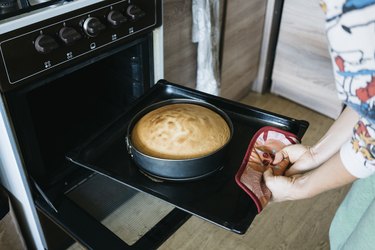Adjusting Cooking Times For Different Temperatures

It's not always possible to follow a recipe to the letter, especially if you need to alter cooking temperatures.
Image Credit: Cavan Images/Cavan/GettyImages
It's not always possible to follow a recipe to the letter, especially if you need to alter cooking temperatures. Unfortunately, there's no cooking time conversion chart that fits all scenarios, and adjustments in cooking temperature and time may depend on many factors.
Cooking Time for Proteins
When it comes to preparing proteins, there are many methods of cooking. You can roast in the oven, saute in a skillet or grill on the barbecue. These various cooking methods may also require different cooking times. When adjusting the temperature, you need to alter the cooking time. For example, if you lower oven temperature, lengthen cooking times.
Though there are many variables that affect cooking times when using a new temperature, one thing remains constant with protein foods: the recommended internal temperature to ensure doneness and prevent foodborne illness. For these protein foods, there's no need for an adjusting cooking times for different temperatures calculator. Just use your meat thermometer.
FoodSafety.gov recommends that your proteins reach the following internal temperatures:
- Ground meat (beef, pork, veal, lamb): 160 degrees Fahrenheit
- Ground poultry (chicken, turkey): 165 F
- Fresh steaks, chops: 145 F
- All poultry products: 165 F
- Fresh pork: 145 F
- Precooked pork: 165 F
- Fish with fins: 145 F
- Egg dishes: 160 F
- Casseroles: 165 F
According to the Cleveland Clinic, a 2-pound well-trimmed tenderloin roast baked (roasted) in a 450 F takes 20 to 40 minutes, depending on the thickness of the meat . If you're lowering the cooking temperature to 400 F, though, your cooking time increases. However, you can use your meat thermometer to determine doneness. Start checking at 70 minutes and continue checking every 10 to 15 minutes until your roast reaches 145 F.
Baking Time Temperature Conversion Chart
When it comes to confections, such as cakes and cookies, you need to be careful about adjusting cooking temperature and baking time. The success of your sweet treat may be dependent on the temperature of the oven to get the desired end results.
That being said, you may have some wiggle room with cookies. According to Portland Community College, cookies are typically baked between 350 F and 400 F. Using a higher temperature to bake your cookies may significantly shorten your cooking time and may help you get the crispy texture you're looking for.
Cakes may be a little less flexible than cookies. The optimal baking temperature and cooking time may depend on the size of the pan, type of cake you're making and the richness of your ingredients.
Most cakes, including this LIVESTRONG.com recipe for Pumpkin Chocolate Chip Bundt Cake as well as our recipe for Chocolate Kale Cake With Sea Salt, bake best at 350 F. However, the bundt cake requires an hour in the oven, while the chocolate kale cake takes only 20 minutes.
The one exception is the dark cake pan, which holds in more heat than light-colored baking pans and bakes your cake batter faster. When you're using a dark nonstick pan for baking, you should reduce your baking temperature by 25 F. You may also want to start checking for doneness a few minutes earlier than recommended in your recipe.
Transitioning to a Convection Oven
The convection oven may be the secret to getting through the holiday baking season. These ovens circulate the heat around the food, as opposed to traditional ovens that heat the food from the top or bottom. This heating element means your food cooks a lot faster in a convection oven.
However, you do need to adjust the cooking time and temperature from your original recipe when using a convection oven. Your convection oven may have a guide that provides you with a baking temperature conversion chart. However, the general rule is to decrease the recommended cooking temperature by 25 F and start checking for doneness five to 10 minutes sooner than called for in your recipe, according to Consumer Reports .
The convection oven works best for baking cookies, biscuits, yeast bread and pizza, but tends to dry out cakes and cupcakes.
You can use your convection oven to roast meat or chicken. However, to prevent your protein from drying out while it cooks, apply a dry brine and refrigerate for an hour to help seal in the juices. The salt from the brine dissolves some of the protein in the meat to help seal in the moisture, according to the USDA.
Adjusting Cooking Times For Different Temperatures
Source: https://www.livestrong.com/article/536192-how-to-convert-cooking-times-to-new-temperatures/
Posted by: mitchellsallation.blogspot.com

0 Response to "Adjusting Cooking Times For Different Temperatures"
Post a Comment